Knuckle (Trench) Knives
BC-41
As Britain prepared for war, they fully expected that the war in Europe would once again turn into the horrors of Trench warfare. As such, they developed a knife that was very similar to the knuckle-duster knives that proved not only popular but effective in the trenches of World War I. While the knives are commonly over-looked they proved quite popular, especially in the first half of the war. As the war progressed, their purpose built trench fighting design fell out of favor for more practical knives. Still they remained very popular at least when it came to impressing the bints at the pub.
For the British the most common of these knives was the BC-41 which combined a set of brass knuckles with a simple steel blade that was bolted or riveted to the grip portion of the knuckles
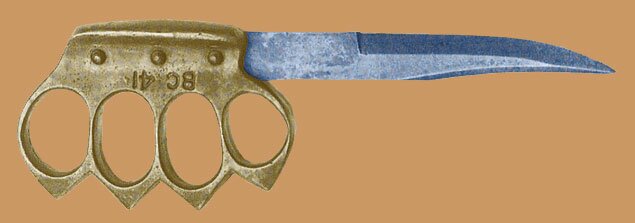
As can be seen the knife was designed to be held with the thumb at the pommel and the blade side pointed down. so that the wielder would be able to punch a man and then while the man is on the ground could stab him in the chest or so that when fighting you could back-slash across the face or chest. The knife was less effective when the thumb was held at the blade end.
Midddle East Commando Knife
Similar to the BC-41, the Middle East (ME) Commando* used a knuckle-duster pattern that allowed two fingers in each holes. The handles was shaped look like the top part of a skull. Two types of blades were used on this knife. The most common was a single edged style blade as seen in the example below (the sharpened edge is the curved edge of the blade). The second style was similar to the stiletto style used on the FS fighting knife. As these knives were issued to members of ME Commando, they most likely found there way among the members of the LRDG and SAS. The brass knuckles of the ME Commando knife were often cast locally and varied greatly in not only general shape but metal composition with many being made from iron.
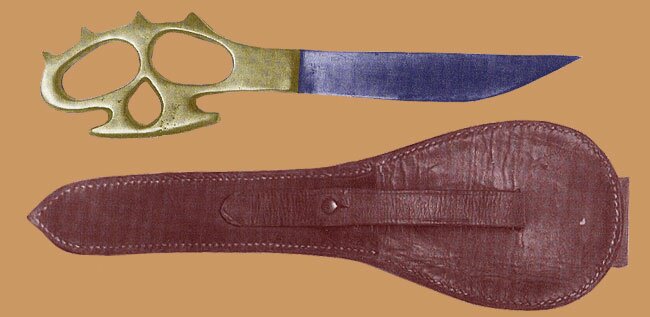
Specifications for both knives (Approximate)
- Overall length: 11 inches (28 cm)
- Length of blade: 6.5 inches ( 17 cm)
* ME Commando, more specifically No. 50 & 52 Middle East Commando were locally raised Commando units that were drawn from British forces stationed in the Middle East at the outbreak of War. They were later made part of Layforce which would subsequently be disbanded. David Stirling and Paddy Mayne, among others were former members of Layforce.
Commando Daggers
Fairbairn Sykes Fighting Knife
One of the most recognized fighting knives in the world, often called the Commando knife or dagger. The FS Fighting Knife was standard issue for most Commando Brigades. While I have not seen photographic evidence of its use by the LRDG. it is assumed they were issued this knife.

FS Pattern 1 (replica)

FS Pattern 2 (replica)

FS Pattern 3

FS Sheath (forearm or belt)
In 1940, Capt. William Ewart Fairbairn and Capt. Eric Anthony Sykes the Fairbairn Sykes Fighting Knife. The first production run was referred to as the 1st Pattern. This model identified with it's classic "S" guard and flat ricasso. These were made in limited numbers.
Next came the 2nd Pattern with a straight cross guard diamond knurled pattern grip, and rounded ball end. and finally the 3rd Pattern with the ringed no-slip grip and cruder workmanship. The 2nd and 3rd pattern would have been most common in the desert campaign. Today, the 3rd pattern is still issued but all patterns are produced as a replicas by many knife makers.
The original Fairbairn Sykes Pattern 2 and 3 were finished in dull black finish with a balance point just behind the cross guard where the index finger would meet the grip, which allowed the knife to be used as a throwing knife.
The sheath was leather with a brass chafe (tip). It was designed to be worn strapped to a leg or forearm or hung from a belt.
Specifications, all patterns.
- Overall length: 11.5 inches (29.21 cm)
- Length of blade: 7.5 inches (19.05 cm)
British Army Clasp Knife (pocket knife)
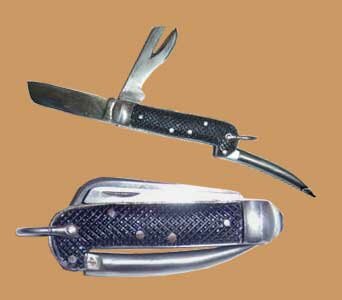
While hardly a fighting knife, the British Army Clasp Knife was an important utility knife. The knife itself consist of s small knife blade (sheep's foot), a can opener, a screwdriver point(on end of grip), and rather large marline spike (the curved spike).
The model to the left is made by Sheffield in 1941. Similar models are made today but with a stainless steel grip.
Overall length, folded 4 inches (about 10cm)
British Military Pattern Locking Blade (Jack Knife)
The Military Pattern jack knife consisted of a single bladed knife that would lock in place once opened, making it safer to use when cutting. Despite the much sharper point, the knife was still a utility knife designed for small jobs such as cutting small wire, chords or even chunks of plastic explosives. This particular type of knife was issued to Commandos and the SOE and dropped by the thousands over occupied Europe for use in sabotage operations. Later versions had a small hook like blade added to the butt end of the handle that was used for slashing tyres.
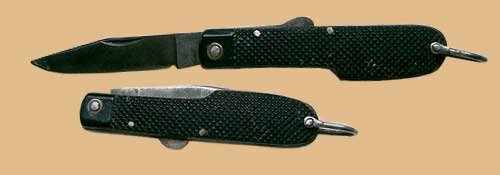
- Overall Length: 4.5 inches (11.5 cm)
- Blade: under 4 inches
Military Pattern Flick Knife (swtichblade)

The British Military Pattern Flick Knife bears a striking resemblance to the Luftwaffe's gravity knife issued to pilots and paratroopers. The main difference is the German gravity knife had a natural wood handle and the British produced flick knife had grips made of black bakelite. The knife was primarily issued to the Paras, S.O.E. and Commandos. The knife may have been used by the LRDG. The flick knife was not a fighting knife. Its purpose was to allow one handed opening of a utility knife as this was sometimes extremely important under combat conditions. (For instance when trying to cut det cord while holding an explosive in place or when one hand is applying pressure to an arterial wound and you need to cut free webbing or clothing on an injured mate.) Flick knives and other pocket knives are small and easily carried and concealed making them essential for a troopers bail-out kit. (Unlike a gravity knife which opened with the assistance of gravity, the flick knife has a spring loaded blade. This pattern seems to have an OTF or out the front blade opening.)
- Overall Length: 4.5 inches (11.5 cm)
- Blade: under 4 inches
Pattern 1907, Mk1 "SMLE" Bayonet (Sword Bayonet)
The sword bayonet continued service in WWII especially among ANZAC forces who retained the SMLE rather than adopting No. 4 Enfield Rifle. While intimidating and impressive to look at, the blade was heavy and for some people this made it more difficult to sight the rifle when the bayonet was fixed. The bayonet dated from before WWI (1907) and remained relatively unchanged being manufactured by numerous companies in Britain and throughout the Commonwealth. The Indian Army produced a shorten version of the bayonet for use in their Army.

Sword Bayonet with 1907 pattern frog and scabbard
- Overall length 21.75 inches (55.25 cm)
- Blade Length 17 inches (43.2 cm)
No.4 Mk.1 Socket Bayonet (Spike Bayonet)
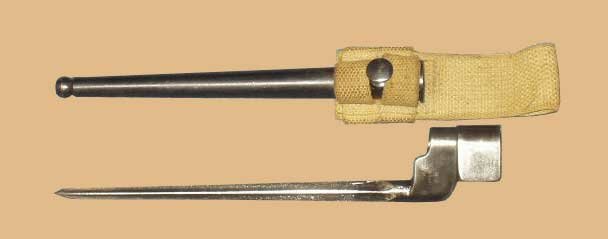
Recognizing some of the disadvantages of the longer sword bayonet, the British Army devised a light weight socket bayonet for use with the No. 4 Enfield rifle. While lighter the socket or spike bayonet lacked a handle and was virtually useless for anything other than a bayonet.
- Overall length: 10 inches (25.4 cm)
Read more about weapons:
